| Devil Dogs:
Publisher’s Preview
By Mike Bennighof, Ph.D.
November 2024
 The general got the Croix de Guerre The general got the Croix de Guerre
The son of a bitch was never there
Hinky dinky parlez-vous
Two hundred fifty U.S. Marines entered the Wheatfield at Belleau Wood on 6 June 1918; nineteen made it to the other side. The Marine Brigade’s commander, Army Brig. Gen. James Harbord, did not actually win the coveted Croix de Guerre, but the entire brigade received both the medal and the name “Devil Dogs,” supposedly given by German prisoners to note the Marines’ ferocity in combat.
Infantry Attacks: Devil Dogs is our game of U.S. Marine actions in the First World War: at Soissons, Blanc Mont Ridge, in the Meuse-Argonne and of course at Belleau Wood. It’s meant as an introduction to the series, though the first three games (August 1914, Fall of Empires and Black Mountain) have been very popular (by our standards, anyway) already.
Infantry Attacks units are infantry companies, artillery batteries and cavalry squadrons. The map scale is 200 meters across each hexagon; each turn represents 15 minutes of actual time. The latter two are the same as Panzer Grenadier, our World War Two tactical series, where most units are platoons rather than companies.
 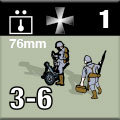 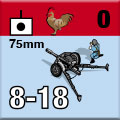 
It’s an interactive game system, where the action is driven by leaders. Like Panzer Grenadier, your troops won’t move toward the enemy unless a leader tells them to do so. It’s called Infantry Attacks for a reason: it’s the infantry who give you staying power, who can take and hold ground. Artillery can hurt them, and cavalry can prance about and sometimes embarrass them, but it’s the infantry who rule the battlefield.
Devil Dogs introduces some additional aspects to the game system, as compared to the games set in 1914. Artillery is more sophisticated and able to do a few more things, though the really noticeable difference is that there’s so much more of it. Overall, it’s far more deadly – unlike the 1914 games, there’s almost always going to be off-board artillery, and your troops are far less likely to avoid enemy shells. And then there’s poison gas to impede your movement. German storm troopers to sneak into your lines (or disrupt the enemy). Masses of machine guns. And tanks! There’s no cavalry in Devil Dogs, but you can’t have everything.
Devil Dogs opens in March 1918, as the first Marine rifle companies filter into the line in a “quiet” sector near Verdun for their first taste of combat. But the real action begins in late May, when the Marines move to Chateau-Thierry to stem a German offensive. Following that came a summer of intense action at Belleau Wood and Soissons; the 4th Marine Brigade suffered over 9,000 casualties at Belleau Wood (over 100 percent of its authorized strength) and another 50 percent at Soissons.
   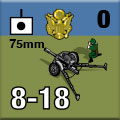
The Marines served in two roles during the Great War: as a fire brigade against German breakthroughs, and as a spearhead of Allied offensives, both American and French. Well-led, at least at the field grade, with spirited morale at a time when their French allies and German enemies showed significant war-weariness, the Marines fought well despite coming to France with shockingly primitive tactics. Only a single brigade (4th Marine Brigade) fought in the front lines; a second brigade arrived in France in the fall of 1918 but the American Expeditionary Force headquarters, annoyed at the press attention given the Marines, used them as rear-area security rather than form an entire division of Devil Dogs.
We tell that story in our story-arc format: the game’s scenario set is broken into chapters (which is pretty easy, since the brigade was rushed from one place to another, wherever the fighting was the thickest). Each chapter sets up the situation with historical background of the battle, the forces that fought it and their objectives. The scenarios then tell the rest of the story, moving it along from action to action. And then there’s a battle game that ties the scenarios together, so you can play all of the scenarios in the chapter and then measure your performance in meeting your side’s operational goals. You don’t have to play the battle game, but it’s an option for added fun.
   
Devil Dogs includes the entire 4th Marine Brigade: the 5th and 6th Marine Regiments and 6th Marine Machine-Gun Battalion. The Marine brigade did not include its own artillery, and so Devil Dogs includes U.S. Army and French field guns. There’s also a detachment of French Renault light tanks, which fought alongside the Marines at Blanc Mont Ridge, and the French infantry that accompanied them (French tank battalions at this time included their own integral infantry).
The Marines are very good infantry, with high morale and plenty of leaders. Their firepower is strong within the rifle companies; their machine-gun units depend on the crapulent French Chauchat (show-show to the Marines) machine gun and are not that good compared to the U.S. Army units wielding the new Browning medium machine gun.
Opposing them, the German Army has suffered four years of brutal attrition. Its rifle companies are sorely depleted, and what soldiers they have are not impressive physical specimens as hunger has reached even the front lines. To make up for their lack of manpower, the front-line companies have been allotted copious numbers of automatic weapons (the same solution would be used in 1944), and more machine-gun platoons on top of that.
 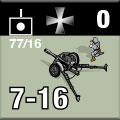 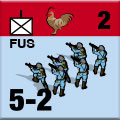 
Their best guys are concentrated in Storm companies, which are not only stronger and more maneuverable, but have special powers when attacking. They’re not bad on the defense, either, but are really wasted there. Their job is to infiltrate Allied defenses and break them open, usually with the aid of careful artillery fire plans and sometimes gas, too.
The late-war Germans have a slightly different color scheme, to easily differentiate them from those of August 1914. The Marines likewise have a color scheme new to Infantry Attacks, based on their traditional colors and globe-eagle-and-anchor symbol. The pieces themselves are our wonderful die-cut and silky-smooth type, cut by such fantastically sharp blades that there’s no Marianas-Trench-sized depression crushed into the flip side – we have to mark the other side, or else you can’t tell the difference between front and back.
With a popular topic, intense action and a great story, we’re looking for Devil Dogs to vault Infantry Attacks to a new level. You’re gong to want this game.
Click here to join the Gold Club.
See your Gold Club Insider newsletter for ordering information.
Sign up for our newsletter right here. Your info will never be sold or transferred; we'll just use it to update you on new games and new offers.
Mike Bennighof is president of Avalanche Press and holds a doctorate in history from Emory University. A Fulbright Scholar and NASA Journalist in Space finalist, he has published a great many books, games and articles on historical subjects; people are saying that some of them are actually good.
He lives in Birmingham, Alabama with his wife, three children, and new puppy. He misses his lizard-hunting Iron Dog, Leopold.
Daily Content includes no AI-generated content or third-party ads. We work hard to keep it that way, and that’s a lot of work. You can help us keep things that way with your gift through this link right here.
|
